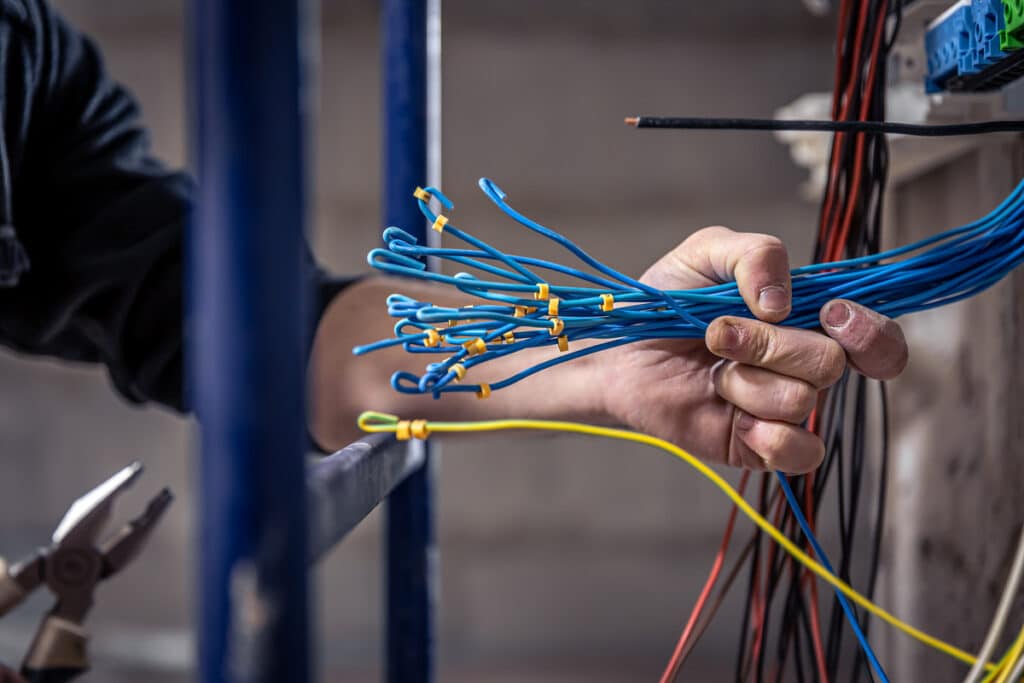When you think about network design, the cabling infrastructure might not be the first thing that comes to mind. Yet, it’s a fundamental component that can make or break your network’s performance.
The right cabling infrastructure ensures seamless data transmission, reduces downtime, and enhances overall network reliability. In this guide, we’ll walk you through the essentials of structured cabling and point-to-point cabling, their benefits, drawbacks, and how to choose the best option for your organization.
Understanding Structured Cabling
Structured cabling is a standardized approach to network cabling that involves a systematic arrangement of cables and hardware components. This method ensures a reliable and scalable network infrastructure that can easily accommodate future expansions.
Benefits of Structured Cabling
- Scalability
Structured cabling is designed to support future growth. Whether you’re expanding your office or upgrading your network equipment, this approach makes it easy to add new devices without disrupting the existing setup.
- Organization
A well-organized cabling system reduces clutter and makes it easier to manage and troubleshoot network issues. Color-coded cables, labeled ports, and standardized connections ensure a clean and efficient network layout.
- Ease of Management
With structured cabling, maintenance becomes a breeze. IT teams can quickly identify and resolve issues, leading to reduced downtime and improved network performance.
Disadvantages of Structured Cabling
- Upfront Cost
The initial investment for structured cabling can be high, especially for smaller networks. However, the long-term benefits often outweigh the upfront costs.
- Requires Professional Installation
Structured cabling requires a professional installation by trained technicians to ensure proper organization and functionality. This can add an extra layer of cost and complexity to the process.
Applications of Structured Cabling
Structured cabling is commonly used in various industries, including:
- Corporate Offices
Large enterprises rely on structured cabling to support their extensive network infrastructure, ensuring seamless communication and data transfer.
- Data Centers
Data centers require a highly reliable and scalable network setup. Structured cabling provides the necessary foundation for efficient data storage and retrieval.
- Educational Institutions
From universities to K-12 schools, structured cabling supports the growing demand for digital learning tools and resources.
Exploring Point-to-Point Cabling
Point-to-point cabling involves direct connections between network devices, such as servers and switches. This method eliminates the need for intermediate patch panels and simplifies the cabling process.
Advantages of Point-to-Point Cabling
- Simplicity
Point-to-point cabling is straightforward and easy to implement. There are no complex cabling structures or extensive planning required, making it a quick solution for small-scale networks.
- Cost-Effective
With fewer components and shorter cable lengths, point-to-point cabling can be more cost-effective initially. It’s an attractive option for startups and small businesses with limited budgets.
- Low Latency
Direct connections between devices reduce latency and improve data transfer speeds, which is beneficial for applications requiring real-time data processing.
Disadvantages of Point-to-Point Cabling
- Limited Scalability
Point-to-point cabling is not ideal for growing businesses. Adding new devices can be challenging and may lead to a tangled mess of cables, which could make the network difficult to manage.
- Maintenance Challenges
Troubleshooting network issues in a point-to-point setup can be time-consuming. The lack of organization and standardized connections increases the risk of errors and downtime.
- Lack of Flexibility
This approach lacks the flexibility to adapt to changing network requirements. Any modifications or expansions can disrupt the entire network.
When to Use Point-to-Point Cabling
Despite its limitations, point-to-point cabling may be suitable for:
- Small Offices
For small businesses with minimal network requirements, point-to-point cabling offers a simple and cost-effective solution.
- Temporary Setups
Temporary installations, such as event or conference networks, can benefit from the quick and easy deployment of point-to-point cabling.
- Specialized Applications
Certain applications, like high-frequency trading, require ultra-low latency and can benefit from the direct connections of point-to-point cabling.
Important Factors to Consider
Should your business use structured cabling or point-to-point? Here’s how to decide.
Network Requirements
Your network’s specific needs play a crucial role in determining the right cabling approach. Consider factors such as the number of devices, data transfer rates, and the need for future scalability.
Bandwidth, Speed, and Future Scalability
Structured cabling is designed to support high bandwidth and fast data transfer speeds, making it ideal for businesses with growing data demands. On the other hand, point-to-point cabling may suffice for smaller networks with lower bandwidth requirements.
Budget Considerations
While structured cabling may have higher initial costs due to the need for standardized components and professional installation, it offers long-term savings through reduced maintenance and scalability. Point-to-point cabling may be more affordable initially but can lead to higher expenses down the line due to maintenance challenges.
Physical Environment
The layout, size, and accessibility of your building or facility also influence the choice of cabling. Structured cabling is suitable for larger spaces with complex network requirements, while point-to-point cabling may be sufficient for smaller, simpler setups.
Consult with Cabling Professionals
For expert advice tailored to your specific needs, consider consulting with cabling professionals like Simple Systems.Their expertise can guide you in making the right choice and ensure a smooth implementation process.
Build the Right Cabling With Simple Systems
Still unsure about the best cabling solution for your network? Reach out to Simple Systems today and let their team of experts help you build a reliable, scalable, and efficient cabling infrastructure.


